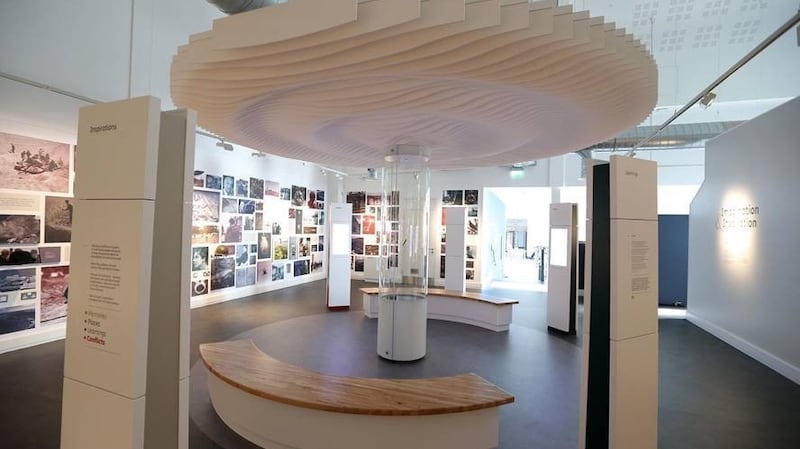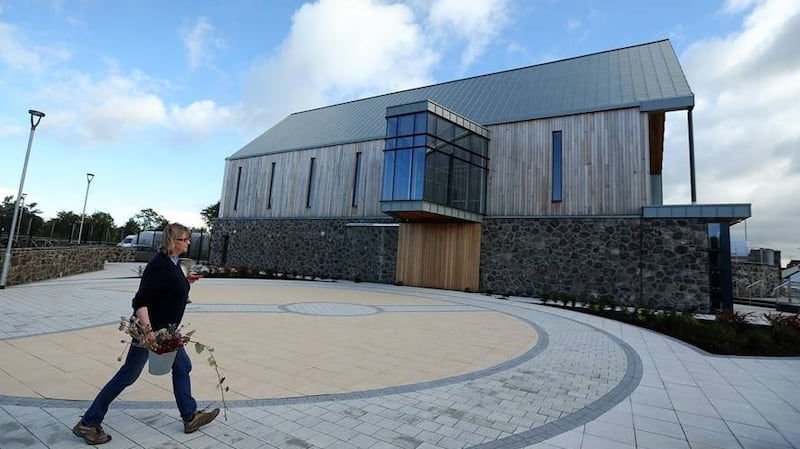Black-and-white photographs. A battered school satchel. An ink-stained desk.
Personal objects like these are at the heart of the new centre dedicated to Seamus Heaney which opens in Bellaghy, Co Derry, this evening.
“It’s like walking round our family album,” says Heaney’s son Christopher.


“We were well used to seeing pictures of Dad when he was alive, we would go to readings and book launches and see his image blown up so that’s not alien to us at all, but seeing your own image, or your aunt or uncle’s or grandfather’s or daughter’s image, well, that is a little strange.
“But it’s done because it informs the work, because there is a piece of work which relates to that object or that image. It’s relevant.”
The Seamus Heaney HomePlace – which artistic director Sean Doran believes is the first purpose-built centre dedicated exclusively to literature on the island of Ireland – aims to use these artefacts to take visitors on a journey through the Nobel Prize-winning poet’s life and literature.
The cornerstone of the centre, the permanent exhibition entitled Seamus Heaney: Man & Boy, is filled not just with personal stories and objects related to the poet’s life, but video recordings from friends and neighbours, a reconstruction of his Dublin study, and – most poignantly of all – the voice of Heaney reading his own work.
It also features The Helicon, a 189-seat performance space inspired by Greek theatre, areas dedicated to learning and education, a cafe and an annex for community use, as well as a library containing books from Heaney’s own home.
The effect throughout is surprisingly intimate for such a large building, and is evidence of the care taken by Mid-Ulster District Council that the HomePlace should reflect Heaney’s love for, and affinity with, the people and places around his childhood home.
A viewing point allows visitors to gaze over the rural landscape which inspired Heaney, while a series of trails are planned for the surrounding area which incorporate locations – Mossbawn, Toner’s Bog, Barney Devlin’s Forge – made famous by his poetry.
“It’s a testimony to Heaney’s importance as a writer of global note, but also how much he was loved as a man,” explains council chairman Trevor Wilson. “His work was rooted in this place, as was he, and as you move through the exhibition you will see just how important these people and this place were to him.”
From the project’s inception, the council has worked closely with the Heaney family.
“It’s intensely gratifying,” says Christopher Heaney. “We were here in May for a pre-launch but it was just a shell with nothing inside, so yesterday was actually the first time we saw it properly.
“You wouldn’t be human if you didn’t have some slight butterflies in the stomach, but I have to say when we saw it we were all just delighted with it. It’s been extremely sensitively done, and what’s important is that at the core of it is the work, the poems.”
Heaney’s poems, and the distinct language he employed, are everywhere in the HomePlace, emblazoned on walls and spoken aloud as visitors move through the centre.
“That’s as it should be, and I think it’s what he would have wanted,” adds Heaney. “The objects are important, because a lot of his poems have a materiality about them, a physicality, and there are a lot of rural implements – like the turnip-snedder – which is important because there’s a physicality and a heft to a lot of the work.
“One feature I love is the word hoard, with the words strung together and hanging down, partly because the words themselves will have people reaching for their dictionaries or their poetry books.
“I don’t know all of them,” admits Heaney, “but I do know quite a few, and there’s the odd one he would have used himself in everyday speech and not just on the page.
“Hoke, he would definitely have used hoke about, and glit, that’s a word that’s been passed down through the genes, it means filth and mud.
“Scobe – I don’t know if scobe is there but scobe was a favourite word, I’m not sure if it ever appeared in a poem but scobe means to hollow out, to scobe at something.
“I remember he always said a pig would scobe at a turnip, hollowing it out, scobing away at it.”
An impressive programme of events is planned for both the opening weekend and the year ahead, in which the 12 months of the year follow the 12 original volumes of Heaney’s poetry.
Highlights include Heaney, Sir: St Columb’s Remembered, with ex-pupils including Phil Coulter and Heaney’s fellow boarder and room-mate Fr Liam Donnelly, as well as dramatised readings which begin in October with Death of a Naturalist and end in a year’s time with Human Chain.
The hope is that Heaney’s love of language will inspire the poets and scholars of the future.
“It’s important that people know it’s not just a Seamus Heaney exhibition,” explains Christopher Heaney. “Yes, the exhibition is there but the arts now have their place in the community and there is a space for community arts to happen and I think that’s a fantastic legacy.”
It’s a legacy that Christopher Heaney feels would make his father proud.
“Bellaghy is the place for it really, he was born close to here, he’s buried here, so it is very much a home place, and I think he’d be gratified.
“Knowing Dad, I think there would be a little bit of him that would be slightly awed, as we all are awed, awed in the best possible sense.”
Freya McClements is a writer and arts journalist based in Derry
















